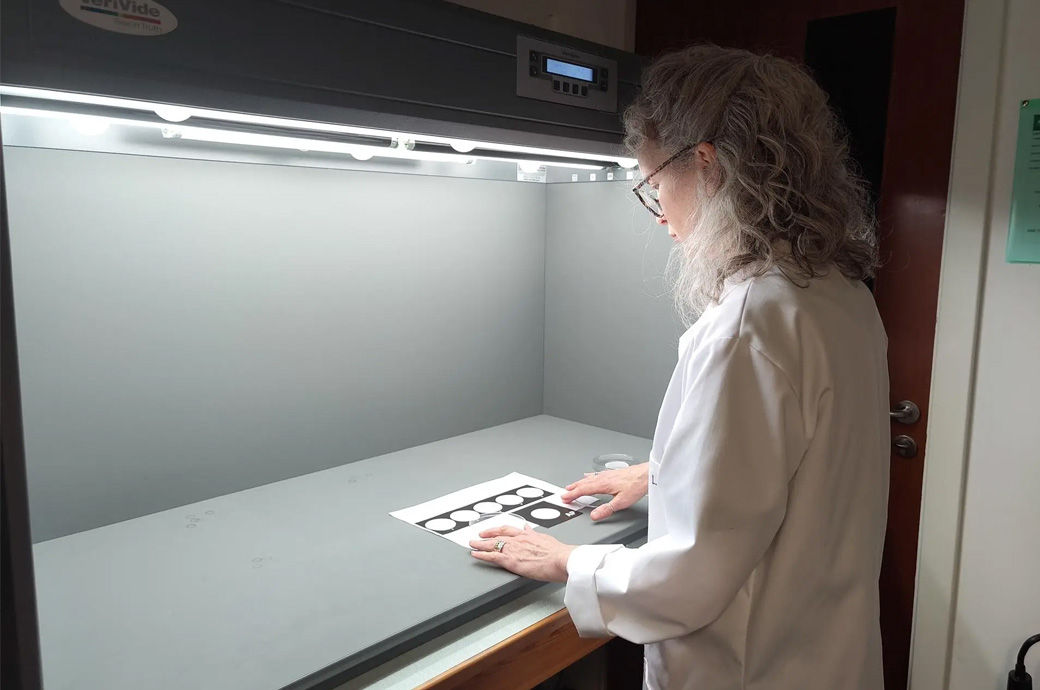
A small team headed by Dr Lisa Macintyre, associate professor of textiles at Heriot-Watt University’s School of Textiles and Design in the Galashiels campus, has overseen painstaking research to co-develop the world’s first visual ‘fibre fragmentation scale’.
This new project led by textile experts is aiming to make fashion labels and consumers alike, more environmentally aware when manufacturing and buying new clothes.
“There are fibre fragments absolutely everywhere, from icebergs to the deepest ocean to human lungs and our food, they’re in everything,” said Macintyre.
The five-point scale assesses the volume of fibre fragments shed from different clothing materials, with observers visually grading each between one and five. Grade one having the highest volume of shed fibres to grade five having the least.
This new method is faster and more cost effective when processing a large volume of materials than compared with alternative techniques. This holds significant advantages to manufacturers as they can quickly identify low shedding materials and select these for further testing to determine their suitability for garment production. Existing methods, such as those used by the International Organisation for Standardisation (ISO), are more expensive and time-consuming.
The findings have been featured in a paper, entitled, Low-cost, high-throughput quantification of microplastics released from textile wash tests: Introducing the fibre fragmentation scale, and published today (19 Nov) in the peer-reviewed journal, Cambridge Prisms: Plastics.
“The microplastics problem is massive. Fashion and textiles is one of the biggest sources of secondary microplastics in the environment with fragments of plastic fibres, like polyester and nylon, being shed from clothing. There are fibre fragments absolutely everywhere, from icebergs to the deepest ocean to human lungs and our food, they’re in everything. Visual scales are already used in the fashion industry to measure how much bobbling a material may suffer on its surface for example or, perhaps the most well-known is the grey scale, which measures colour fading or staining, but there was no such tool for fibre shedding,” Macintyre said.
“This project aims to change that and allow manufacturers to not only make better choices in production but also to communicate to their customers in a very simple and straightforward way, the typical amount of fibres shed from a garment,” explained Macintyre.
Thousands of tiny fibres can be shed from some clothing through daily wear and tear, including laundry. They are typically very thin, ranging in size from a fraction of a millimetre to several centimetres in length. Despite their small size, they can inflict substantial harm on ecosystems, animals, and human health, potentially leading to cellular damage and inflammation.
In testing their new scale, the academics used a machine containing eight separate canisters, known as a ‘rotawash’.
Textile samples were placed within the canisters, filled with water and then churned to replicate a washing machine cycle. The wastewater was then filtered, allowing the testers and observers to visually grade the shed fibres against the scale.
Some 46 testers from the fashion industry, university students and the public volunteered in the project grading around 100 samples over two years.
Sophia Murden is in her final year studying for a PhD in fibre fragmentation testing at Heriot-Watt University. She has been working alongside Macintyre in developing the fibre fragmentation scale and says this is the first time that a visual scale has been developed.
“Our methodology is simple and cost effective. The filters used to collect fibre fragments from laundry wastewater can be graded against our five-point scale, which surprisingly is more accurate at assessing very low levels of fragmentation than the equivalent method of weighing fibres. The ultimate aim is for manufacturers to choose materials that are going to have the least impact on our environment but also allow consumers to make an informed decision when they buy their clothing,” she said.
If adopted by industry, the fibre fragmentation scale could be displayed on clothing labels, similar to the way many UK food manufacturers display calorie information on packaging.
“We’ve already been in contact with the likes of Helly Hansen and Lochcarron of Scotland who are very supportive of what we are doing. The next stage for us is to try and get some kind of industry agreement. Currently, we don’t have an ‘acceptable fragmentation’ rate for clothing but that’s not unusual. The environment is an important issue, and we’d want to get key industry leaders and policymakers to sit down and start agreeing standards, perhaps even legislating against high shedding materials,” Macintyre added.
The project has been funded through the University’s James Watt Scholarship which is aimed at advancing research for the benefit of society.
Fibre2Fashion News Desk (RR)